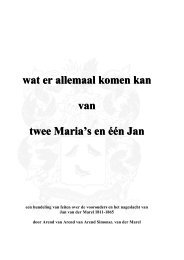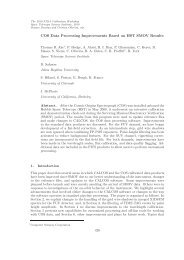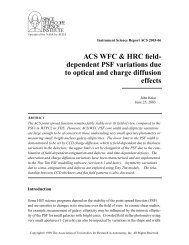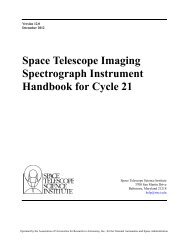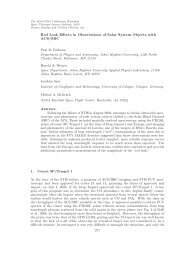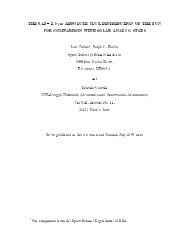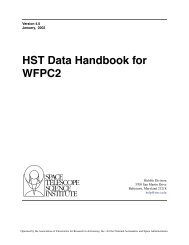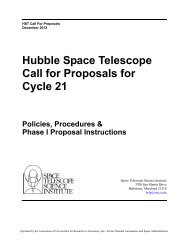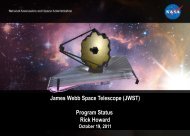STScI Annual Report 2002: A Living Mission
STScI Annual Report 2002: A Living Mission
STScI Annual Report 2002: A Living Mission
You also want an ePaper? Increase the reach of your titles
YUMPU automatically turns print PDFs into web optimized ePapers that Google loves.
profiles<br />
Lisa Wolff<br />
Lisa Wolff joined the Institute in<br />
<strong>2002</strong> and serves as the Chief<br />
Information Officer.<br />
Lisa attended the University of Maryland’s Clark<br />
School of Engineering in College Park. She joined the<br />
Institute in <strong>2002</strong>, after making the decision to leave<br />
an 18-year career in the research and engineering<br />
field. Lisa’s decision to join the Institute was heavily<br />
influenced by her interest in mathematics, physics,<br />
and software engineering.<br />
The appeal of electrical engineering surfaced in the<br />
early 1980s, while Lisa was employed at IIT Research<br />
Institute (IITRI). She designed RF (radio-frequency)<br />
shielded enclosures, developed printed circuit cards<br />
for avionics systems, and worked on various research<br />
initiatives. Lisa took on the technical and cultural<br />
challenge of introducing Computer Aided Design (CAD)<br />
to IITRI’s engineering staff. Although an emerging<br />
technology at the time, Lisa recognized the revolutionary<br />
change that this technology would bring to<br />
the engineering and manufacturing industry. Clearly,<br />
expertise in this technology would be a critical element<br />
to an engineer’s success. Lisa set both educational<br />
and career courses to gain that expertise.<br />
One year after the successful introduction of CAD at<br />
IITRI, Lisa accepted employment with US Design, a<br />
subsidiary of Maxtor Corporation. She designed cache<br />
controllers and managed the design environment. The<br />
breadth of CAD technology was growing wider, encapsulating<br />
the art of electrical circuit design. CAD had<br />
become CAE (Computer Aided Engineering) in recognition<br />
of the new functionality. The CAD industry’s move<br />
to automate more than the physical layout of printed<br />
circuit boards opened new opportunities for Lisa. Now<br />
that the tools were capable of modeling the behavior<br />
of a circuit, Lisa set a new target: to dramatically<br />
improve the design quality and cycle time required<br />
to develop a product. She hit her target through the<br />
broad application of circuit modeling and simulation,<br />
improving information management methods and<br />
re-engineering processes.<br />
16 new manager profile<br />
Roeland van der Marel<br />
Roeland van der Marel came to the<br />
Institute in 1997 as the first Institute Fellow<br />
and currently leads the Advanced Camera<br />
for Surveys Team.<br />
Roeland grew up in The Netherlands. After a few<br />
years in The Hague, he moved to the suburb of<br />
Wassenaar, where he spent most of his childhood.<br />
He acquired a love of the exact and abstract already<br />
at an early age. His brother was devoted to chess,<br />
puzzles, and mathematics and enthusiastically taught<br />
his kid brother whatever he would absorb. As a<br />
consequence, Roeland participated in his first chess<br />
tournament at age seven, with many more to follow.<br />
However, despite moderate successes, the interest<br />
in chess would not stick. While the chessboard<br />
was permanently stored in the closet, a passion for<br />
science in general and astronomy in particular has<br />
remained to this day. Roeland recalls: “I was never an<br />
amateur astronomer. However, I recently came across<br />
some old high school notebooks. Amongst the soccer<br />
teams and rock stars of the day, I noticed a picture of<br />
the Hubble Space Telescope. Apparently, already then<br />
I had a good sense of what I wanted to do in life.”<br />
After high school, Roeland chose to pursue a double<br />
major in astronomy and mathematics at nearby<br />
Leiden University, where Lorentz, de Sitter, Oort, and<br />
others had established a rich tradition in astronomical<br />
research. Although he enjoyed mathematics, it did<br />
not draw him in the same way that astronomy did.<br />
“Astronomy uses advanced, multi-million-dollar<br />
telescopes in exotic places to address questions that<br />
humans have pondered for centuries,” so he explains.<br />
“Mathematics is more abstract and to me just doesn't<br />
radiate the same entrepreneurial spirit.” Roeland<br />
chose to pursue a graduate degree in astronomy. He<br />
had been introduced to the field of galaxy dynamics<br />
during an undergraduate summer project at Oxford<br />
University and chose to make this the topic of his<br />
Ph.D. research.<br />
Some galaxies display pronounced activity in their<br />
centers, which had long been believed to be due to<br />
continued on page 57 continued on page 56



